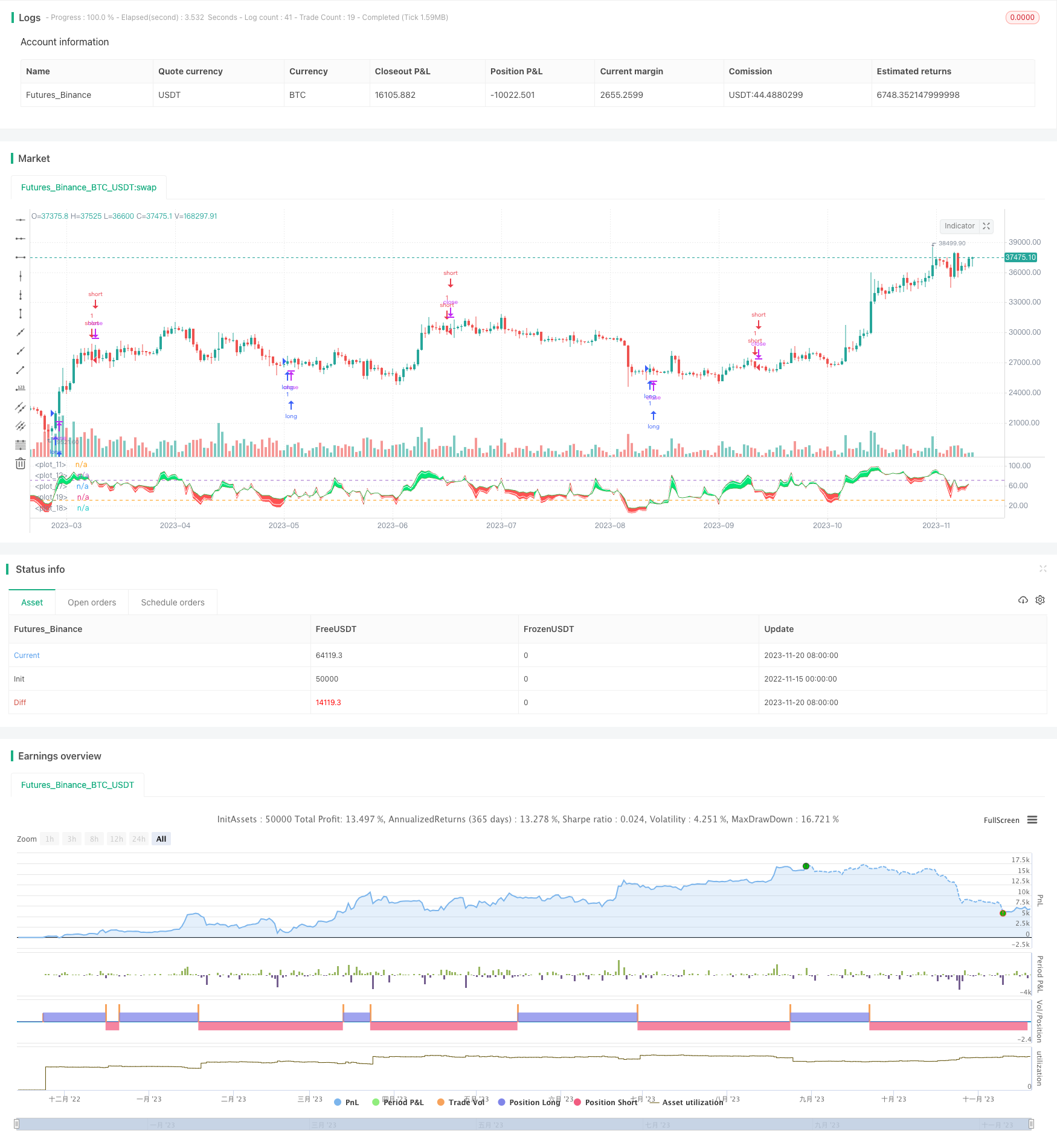
概述
该策略是基于RSI指标的双叉反转原理制定的趋势追踪策略。它使用不同周期的RSI线交叉作为买入和卖出信号,同时结合RSI指标判断目前是否处于超买或超卖状态,进一步确认交易信号的有效性。
策略原理
该策略主要基于5日和11日两条RSI指标线。当 faster RSI(5日线)从下向上突破slower RSI(11日线)而且同时6日RSI低于30时,产生买入信号;当faster RSI 从上向下跌破slower RSI 而且同时6日RSI高于70时,产生卖出信号。
该策略同时绘制出30和70水平线。30代表超卖区域,70代表超买区域。RSI指标的基本思想就是当处于超买超卖区域时,代表资产被高估,应当考虑获利了结或等待回调机会;当RSI处于超卖区域时,代表资产被低估,应当考虑买入建立多头头寸。所以该策略加入6日RSI判断是否处于超买超卖区域,可过滤掉一些假信号,提高信号的可靠性。
在产生买入和卖出信号时,该策略会分别下单做多和做空。所以它是一个双向交易策略,既可跟踪上涨趋势,也可跟踪下跌趋势。
策略优势
- 使用双叉原理,可靠性较高
- 结合不同周期RSI判断,避免假信号
- 可双向交易,适合跟踪市场趋势
- RSI指标性能稳定,参数优化空间大
风险及解决方案
双叉信号滞后,可能错过部分涨跌
解决方法:适当缩短faster RSI的周期参数,使信号更加灵敏趋势市场中可能出现较多假信号
解决方法:调整超买超卖判断区域的参数,避免趋势市场的假信号RSI指标发散或失效的概率
解决方法:与其他指标组合使用,避免RSI单一失效的概率
优化方向
周期参数优化:调整更快速和更慢速RSI的周期参数,寻找最佳参数组合
超买超卖参数优化:调整超买超卖判断区域的参数,提高信号准确率
与其他指标组合:组合移动平均线或波动率指标等,形成综合交易系统
总结
本策略基于RSI双叉反转思路,是一种较为可靠的趋势跟踪策略。它使用多周期RSI判断,可避免一定的假信号,从而具有较高的实战效果。通过参数优化和指标组合,该策略可望获得更出色的表现。总体来说,该策略思路清晰,实用性强,值得重点关注和后续优化。
/*backtest
start: 2022-11-15 00:00:00
end: 2023-11-21 00:00:00
period: 1d
basePeriod: 1h
exchanges: [{"eid":"Futures_Binance","currency":"BTC_USDT"}]
*/
// This source code is subject to the terms of the Mozilla Public License 2.0 at https://mozilla.org/MPL/2.0/
// © email_analysts
// This code gives indication on the chart to go long or short based on RSI crossover strategy.
//Default value has been taken as 5 and 11, with 6 being used to identify highs & lows.
//@version=4
strategy("RSITrendStrategy", overlay=false)
len1 = input(title="MA 1", defval = 5)
len2 = input(title="MA 1", defval = 11)
len3 = input(title="MA 1", defval = 6)
h1 = hline(30.)
h2 = hline(70.)
///fill(h1, h2, color = color.new(color.blue, 80))
sh = rsi(close, len1)
ln = rsi(close, len2)
rs = rsi(close, len3)
p1 = plot(sh, color = color.red)
p2 = plot(ln, color = color.green)
p3 = plot(rs, color = color.white)
mycol = sh > ln ? color.lime : color.red
fill(p1, p2, color = mycol)
buy = (sh[1] < ln[1] and sh > ln and rs[1] < 30)
if (buy)
strategy.entry("long", strategy.long)
sell = (sh[1] > ln[1] and sh < ln and rs[1] > 70)
if (sell)
strategy.entry("short", strategy.short)